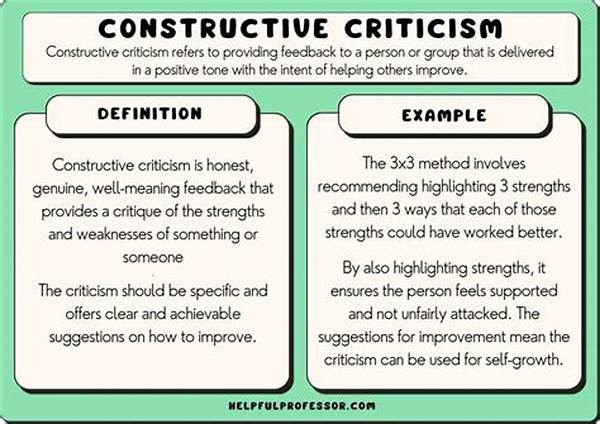Writing is a journey of continuous improvement, a path laden with creativity and personal touch. However, it’s not without its challenges. Constructive criticism for writers plays a crucial role in this journey. It’s indispensable to an author’s development and creative evolution. Let’s explore how constructive feedback serves as a nurturing tool for writers, helping them hone their craft and voice.
The Importance of Constructive Criticism for Writers
Constructive criticism for writers is vital as it provides them the unique gift of perspective. Oftentimes, authors can be too close to their work, entwined in every sentence, making it difficult for them to see aspects that require refinement. Constructive feedback, offered with empathy and respect, acts as a mirror, reflecting parts of their work they might overlook. It teaches them to engage with their audience more effectively by highlighting areas that could enhance clarity, coherence, and emotional impact.
In professional and personal writing pursuits, receiving constructive criticism helps writers remain adaptable. Writers grow by understanding different viewpoints and learning to accept critiques not as attacks, but as guidance to bolster their narratives. This embrace of feedback nurtures a writer’s resilience and encourages a culture of lifelong learning in writing. Ultimately, writers who value constructive criticism set themselves on a path of relentless improvement and creativity.
Techniques to Offer Constructive Criticism for Writers
1. Be Specific: When providing constructive criticism for writers, focus on particular elements rather than vague opinions. This precision helps authors pinpoint what needs work.
2. Balance Positivity with Feedback: Ensure that along with critiques, you highlight what works well in the piece. This balance maintains motivation and morale.
3. Suggest Improvements: Instead of merely pointing out what doesn’t work, offer suggestions on how to enhance those areas. This turns criticism into actionable input.
4. Focus on the Work, Not the Person: Critique the piece itself and refrain from making personal comments. This helps maintain professionalism and objectivity.
5. Encourage Dialogue: Open a channel for discussion to clarify points and allow the writer to express their intentions. This creates an interactive and supportive critique environment.
The Role of Constructive Criticism in a Writer’s Growth
Constructive criticism for writers is akin to mentorship in a writer’s journey. It’s about nurturing potential rather than stifling creativity. Effective feedback not only impacts a writer’s immediate work but also contributes to their long-term writing prowess. When writers understand that criticism is not an ordeal, but a resource, they open themselves to learning and adapting.
Developing a thick skin regarding critiques enables writers to embrace diverse stylistic choices and broaden their literary horizons. What starts as a challenge soon becomes an enjoyable quest of refining one’s voice and venturing into new territories of expression. The art of accepting and integrating constructive criticism fosters a writer’s inner confidence, compelling them to push creative boundaries.
Embracing Constructive Criticism with a Natural Sounding Language
Natural sounding language is key in offering constructive criticism for writers. It’s about expressing feedback in a way that feels genuine and relatable. Using clear and conversational language makes the writer feel more at ease and open to accepting suggestions. Instead of formalities that might come across as harsh, adopt a tone that’s considerate and sincere.
1. Build Rapport: Starting with a friendly note helps set a positive tone for the feedback process.
2. Use Relatable Examples: Illustrate points with examples, making criticism easier to grasp.
3. Employ Empathetic Expressions: Phrases like “I understand where you’re coming from” can soften the impact of criticism.
4. Maintain Clarity and Simplicity: Avoid jargon; clear, simple language directs attention to the essence of the feedback.
5. Personalize the Experience: Tailor feedback to acknowledge the writer’s unique voice and style.
Crafting A Supportive Feedback Environment
Creating an atmosphere where constructive criticism for writers is both accepted and appreciated requires an environment built on trust and mutual respect. When feedback is delivered with a thoughtful approach using natural sounding language, it becomes a powerful catalyst for change and growth.
This system of supportive feedback not only fine-tunes a writer’s skills but builds a community of open-minded and receptive individuals eager to elevate each other’s work. Such environments embody a collaborative spirit where constructive criticism is perceived as a collective effort to achieve excellence rather than a solitary endeavor.
Ultimately, the goal is to propel writers towards creating work that resonates profoundly with their audiences, celebrating the synergy between criticism and artistry. By embracing constructive criticism, writers embark on an endless quest for not just better writing, but transformative storytelling.
Conclusion: The Essence of Constructive Criticism for Writers
To summarize, the natural sounding language of constructive criticism for writers is not about tearing down, but about building. It’s a process of nurturing potential and encouraging exploration in the realm of writing. Constructive criticism serves as a bridge between a writer’s raw ideas and their polished masterpieces.
Writers, both novice and seasoned, who actively seek and embrace constructive criticism find themselves on a continuous learning curve. They grow not only through the words they craft but also through the dialogues and feedback engaging with them. The value of constructive criticism for writers lies in its ability to provoke thought, ignite passion, and inspire a pursuit of excellence that transforms writing into an art form.
